Diana monkey
The Diana monkey (Cercopithecus diana) is an Old World monkey. The term “old-world monkey” refers to the family of monkeys known as Cercopithecoidea and the Diana monkey is only 1 species out of the 148 that are a part of this family.[5]
| Diana monkey[1] | |
|---|---|
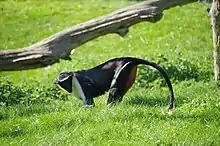 | |
| Diana monkey at the Zoo de la Bourbansais | |
| Scientific classification | |
| Kingdom: | Animalia |
| Phylum: | Chordata |
| Class: | Mammalia |
| Order: | Primates |
| Suborder: | Haplorhini |
| Infraorder: | Simiiformes |
| Family: | Cercopithecidae |
| Genus: | Cercopithecus |
| Species: | C. diana |
| Binomial name | |
| Cercopithecus diana | |
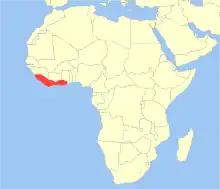 | |
| Combined geographic range of Diana monkey (western half) and roloway monkey (eastern half) | |
| Synonyms[4] | |
| |
Taxonomy
Two taxa formerly considered subspecies of the Diana monkey have recently been elevated to full species status: the roloway monkey (C. roloway) is found in Côte d'Ivoire and Ghana, and the Dryas monkey (C. dryas) found in the DR Congo.
Distribution
This species can be found in West Africa, from Sierra Leone to Côte d'Ivoire.
Habitat
The Diana monkey is found in the primary forests, and does not thrive in secondary forests. The species is regarded as endangered by the IUCN as well as by the United States Fish and Wildlife Service, the chief dangers to them being habitat destruction (they are now virtually confined to coastal areas) and hunting for bushmeat.
Description
The Diana monkey ranges from 40 to 55 cm in length, excluding its tail, which is of a uniform 3–4 cm diameter and 50–75 cm long. Adults weigh between 4–7 kg.
They are generally black or dark grey, but have a white throat, crescent-shaped browband, ruff and beard; the browband gave the species its common name, since it was held to resemble the crescent on the brow of the goddess Diana. The monkeys' underarms are also white, and they have a white stripe down their thighs, while the backs of their thighs, and their lower backs, are a chestnut colour. Apart from the browband, ruff and beard, and some fringes on their limbs, their fur is rough and tough.
Biology and behavior
Individual Diana monkeys may live for up to 20 years. This monkey is active during the day. It feeds at all levels of the canopy, and rarely comes down to the ground. Diana monkeys retreat to the upper levels of the trees at night, though they do not make nests. They feed mainly on fruit and insects, but also take flowers, young leaves, and invertebrates, and are in turn preyed on by the crowned hawk-eagle, the leopard, the common chimpanzee, and humans.
The Diana monkey is a noisy presence in the forest. Its marked coloration allows a wide range of visual social signals. Female Diana monkeys produce specific alarm calls, alert calls and contact calls depending on the differences in predator fauna, suggesting that the flexibility of female calls are better than that of males. [6]
Other forest residents such as the yellow-casqued hornbill are able to discriminate these and take appropriate action.[7]
Diana Monkeys communicate both to local group members and distant competitors with different kind of alarm sounds. Diana Monkeys produce loud noises to make other monkeys aware of leopards or other competitors in their area.
Groups consist of a single male with a number of reproducing females and their infants. In good conditions, adult females reproduce annually. Gestation lasts about 5 months, and the young nurse for a further 6 months. Normally, only a single infant is born. Although the young are born in a fairly well-developed condition, with open eyes and able to grasp their mothers, at least in zoo conditions, Diana monkey mothers appear anxious and possessive, rarely letting young infants leave them. As infants grow, however, they become very playful. Juveniles reach sexual maturity at an age of about 3 years. Daughters remain in their mothers' social groups, while males leave their natal groups shortly before attaining sexual maturity.
Human relevance
Like most primates, Diana monkeys can always carry diseases that can be communicated to humans, like yellow fever and tuberculosis, but they are not important carriers of these.
Gallery
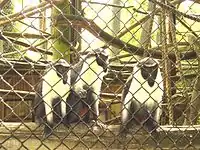 Three Diana monkeys at Port Lympne Zoo.
Three Diana monkeys at Port Lympne Zoo.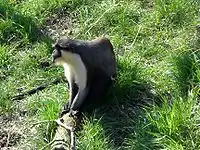 A Diana monkey seen in profile.
A Diana monkey seen in profile.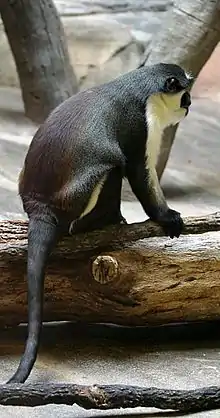 Diana monkey at the Henry Doorly Zoo.
Diana monkey at the Henry Doorly Zoo.%252C_Tierpark_Hellabrunn%252C_M%C3%BAnich%252C_Alemania%252C_2012-06-17%252C_DD_01.jpg.webp) Exemplar in Munich Zoo.
Exemplar in Munich Zoo.
References
- Groves, C. P. (2005). Wilson, D. E.; Reeder, D. M. (eds.). Mammal Species of the World: A Taxonomic and Geographic Reference (3rd ed.). Baltimore: Johns Hopkins University Press. p. 155. ISBN 0-801-88221-4. OCLC 62265494.
- Koné, I.; McGraw, S.; Gonedelé Bi, S.; Oates, J.F. (2019). "Cercopithecus diana". IUCN Red List of Threatened Species. IUCN. 2019: e.T4245A92384250. Retrieved 11 December 2019.
- Linnaeus, Carl von (1758). Systema naturæ. Regnum animale (10th ed.). Guilielmus Engelmann. pp. 26–27. Retrieved 19 November 2012.
- Wilson, D.E.; Reeder, D.M., eds. (2005). "Cercopithecus diana". Mammal Species of the World: A Taxonomic and Geographic Reference (3rd ed.). Johns Hopkins University Press. ISBN 978-0-8018-8221-0. OCLC 62265494.
- Kane, Erin E, and Scott W McGraw. “Dietary Variation in Diana Monkeys (Cercopithecus Diana): The Effects of Polyspecific Associations.” 2017, https://apps.webofknowledge.com/full_record.do?product=WOS&search_mode=GeneralSearch&qid=7&SID=7DwpyFJmnJLWscgNAaM&page=1&doc=8.
- Stephan, Claudia; Zuberbühler, Klaus (18 October 2013). "Predation affects alarm call usage in female Diana monkeys (Cercopithecus diana Diana)" (PDF). Behavioral Ecology and Sociobiology. 68 (2): 321–331. doi:10.1007/s00265-013-1647-x.
- Rainey, H. J.; Zuberbühler, K.; Slater, P. J. B. (2004). "Hornbills can distinguish between primate alarm calls". Proceedings of the Royal Society of London. 271 (1540): 755–759. doi:10.1098/rspb.2003.2619. PMC 1691652. PMID 15209110.
External links
| Wikispecies has information related to Diana monkey. |
 Media related to Cercopithecus diana at Wikimedia Commons
Media related to Cercopithecus diana at Wikimedia Commons
